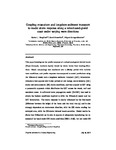Coupling cross-shore and longshore sediment transport to model storm response along a mixed sand-gravel coast under varying wave directions
| dc.contributor.author | Bergillos, RJ | |
| dc.contributor.author | Masselink, G | |
| dc.contributor.author | Ortega-Sánchez, M | |
| dc.date.accessioned | 2017-11-20T09:53:51Z | |
| dc.date.issued | 2017-11 | |
| dc.identifier.issn | 0378-3839 | |
| dc.identifier.issn | 1872-7379 | |
| dc.identifier.other | C | |
| dc.identifier.uri | http://hdl.handle.net/10026.1/10217 | |
| dc.description | publisher: Elsevier articletitle: Coupling cross-shore and longshore sediment transport to model storm response along a mixed sand-gravel coast under varying wave directions journaltitle: Coastal Engineering articlelink: http://dx.doi.org/10.1016/j.coastaleng.2017.09.009 content_type: article copyright: © 2017 Elsevier B.V. All rights reserved. | |
| dc.description.abstract |
This paper investigates the profile response of a mixed sand-gravel deltaic beach (Playa Granada, southern Spain) forced by storm waves from varying directions. Beach morphology was monitored over a 36-day period with variable wave conditions, and profile response was compared to model predictions using the XBeach-G model and a longshore sediment transport (LST) formulation. XBeach-G was applied over 2-day periods of low energy, south-westerly (SW) storm and south-easterly (SE) storm conditions, and was coupled to LST using a parametric approach which distributes the LST across the swash, surf and nearshore zones. A calibrated wave propagation model (Delft3D) was used to obtain the inshore conditions required to drive the XBeach-G model and the LST formulation. The storm response is clearly influenced by the free-board (difference between the height of the berm and the total run-up) and is also strongly dependent on storm-wave direction, with the SW storm eroding the surveyed area, while the SE storm induced beach accretion. Model results indicate that XBeach-G on its own is capable of adequately reproducing the response of the beach under SW storm conditions (BSS>0.95), but not under SE storms due to the higher LST gradients at the study location. The combination of XBeach-G and LST fits the measured profiles reasonably well under both SW (BSS>0.96) and SE (BSS>0.88) storms, inspiring confidence in the coupled model to predict the storm response under varying wave conditions. The combined XBeach-G/LST model was applied to the entire 6.8-km deltaic coastline to investigate the impact of extreme SW and SE storm events, and the model results reiterate the importance of cross-shore and longshore sediment transport in driving coastal storm response at this location. The approach proposed in this work can be extended to other worldwide coasts highly influenced by both cross-shore and longshore sediment transport, such as beaches with different coastline orientations and/or forced by varying wave directions. | |
| dc.format.extent | 93-104 | |
| dc.language | en | |
| dc.language.iso | en | |
| dc.publisher | Elsevier | |
| dc.subject | Storm response | |
| dc.subject | Beach profile | |
| dc.subject | Wave propagation | |
| dc.subject | XBeach-G | |
| dc.subject | Longshore sediment transport | |
| dc.title | Coupling cross-shore and longshore sediment transport to model storm response along a mixed sand-gravel coast under varying wave directions | |
| dc.type | journal-article | |
| dc.type | Article | |
| plymouth.author-url | https://www.webofscience.com/api/gateway?GWVersion=2&SrcApp=PARTNER_APP&SrcAuth=LinksAMR&KeyUT=WOS:000413611200007&DestLinkType=FullRecord&DestApp=ALL_WOS&UsrCustomerID=11bb513d99f797142bcfeffcc58ea008 | |
| plymouth.volume | 129 | |
| plymouth.publication-status | Published | |
| plymouth.journal | Coastal Engineering | |
| dc.identifier.doi | 10.1016/j.coastaleng.2017.09.009 | |
| plymouth.organisational-group | /Plymouth | |
| plymouth.organisational-group | /Plymouth/Faculty of Science and Engineering | |
| plymouth.organisational-group | /Plymouth/Faculty of Science and Engineering/School of Biological and Marine Sciences | |
| plymouth.organisational-group | /Plymouth/REF 2021 Researchers by UoA | |
| plymouth.organisational-group | /Plymouth/REF 2021 Researchers by UoA/UoA07 Earth Systems and Environmental Sciences | |
| plymouth.organisational-group | /Plymouth/Research Groups | |
| plymouth.organisational-group | /Plymouth/Research Groups/Marine Institute | |
| plymouth.organisational-group | /Plymouth/Users by role | |
| plymouth.organisational-group | /Plymouth/Users by role/Academics | |
| plymouth.organisational-group | /Plymouth/Users by role/Researchers in ResearchFish submission | |
| dcterms.dateAccepted | 2017-09-15 | |
| dc.rights.embargodate | 2018-9-26 | |
| dc.identifier.eissn | 1872-7379 | |
| dc.rights.embargoperiod | Not known | |
| rioxxterms.versionofrecord | 10.1016/j.coastaleng.2017.09.009 | |
| rioxxterms.licenseref.uri | http://www.rioxx.net/licenses/all-rights-reserved | |
| rioxxterms.licenseref.startdate | 2017-11 | |
| rioxxterms.type | Journal Article/Review | |
| plymouth.funder | Physical and biological dynamic coastal processes and their role in coastal recovery (BLUE-coast)::NERC | |
| plymouth.funder | Physical and biological dynamic coastal processes and their role in coastal recovery (BLUE-coast)::NERC |


